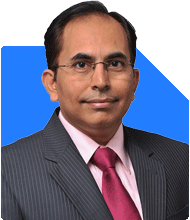Ramalingam Kalirajan |10183 Answers |Ask -Follow
Mutual Funds, Financial Planning Expert - Answered on Jun 29, 2024
He has an MBA in finance from the University of Madras and is a certified financial planner.
He is the director and chief financial planner at Holistic Investment, a Chennai-based firm that offers financial planning and wealth management advice.... more

I am 36 year old and my take home salary is around 1.6, I have an EMI OF 1.02 pending for next 3 year and. I hv 40L in equity, 9 L in mutual and 10 Pf. i have two kids and having expenses around 50k each month. I need 2-3 Cr by my retirement. how can I do that?
Assessing Your Current Financial Situation
You have a solid foundation already, which is fantastic. Here’s a quick snapshot:
Salary: Rs. 1.6 lakh take-home monthly.
EMI: Rs. 1.02 lakh for the next 3 years.
Equity Investments: Rs. 40 lakh.
Mutual Funds: Rs. 9 lakh.
Provident Fund: Rs. 10 lakh.
Monthly Expenses: Rs. 50,000.
Your salary covers the EMI and expenses, but saving more is challenging right now.
Building a Strong Savings Plan
Once your EMI is paid off in 3 years, you'll have Rs. 1.02 lakh freed up each month. This is a significant amount that can be redirected towards savings and investments. Here’s how you can plan:
Start a systematic investment plan (SIP) with the freed-up EMI amount.
Divide the amount between equity mutual funds, PPF, and other fixed-income instruments.
Consider a mix of large-cap, mid-cap, and small-cap funds for diversification.
Boosting Your Mutual Fund Portfolio
You already have Rs. 9 lakh in mutual funds. Increasing this amount through regular SIPs can yield significant returns. Here’s why mutual funds are a good option:
Professional Management: Fund managers have expertise in stock selection and market timing.
Diversification: Mutual funds spread your investment across various sectors and stocks.
Flexibility: You can start with small amounts and increase your investment over time.
Maximizing Your Equity Investments
Your equity portfolio of Rs. 40 lakh is a strong asset. Equity investments can provide high returns over the long term. Here’s how to manage it:
Review and Rebalance: Regularly review your portfolio and rebalance to align with your risk tolerance.
Stay Invested: Avoid frequent trading and let your investments grow over time.
Seek Professional Advice: A Certified Financial Planner (CFP) can help optimize your portfolio.
Leveraging Your Provident Fund
Your Provident Fund (PF) of Rs. 10 lakh is a safe and secure investment. It provides a steady return with tax benefits. Here’s how to make the most of it:
Continue Contributions: Ensure you keep contributing to your PF.
Use PF for Long-Term Goals: Treat your PF as a long-term investment for retirement.
Planning for Your Children’s Future
With two kids, it’s essential to plan for their education and other expenses. Here are a few steps:
Education Fund: Start an SIP specifically for their education.
Child Plans: Consider child-specific investment plans for their future needs.
Insurance: Ensure you have adequate life and health insurance to cover unforeseen events.
Cutting Down Unnecessary Expenses
Review your monthly expenses and identify areas where you can save. Here are some tips:
Budgeting: Create a monthly budget and stick to it.
Track Expenses: Use apps to track your spending and find areas to cut back.
Prioritize Needs Over Wants: Focus on essential expenses and avoid unnecessary spending.
Creating an Emergency Fund
An emergency fund is crucial for financial stability. Aim to save at least 6 months of expenses. Here’s how:
Set Aside a Fixed Amount Monthly: Once your EMI is paid off, allocate a portion to an emergency fund.
Use Liquid Funds: Invest in liquid funds or a high-interest savings account for easy access.
Avoid Using This Fund: Only use it for genuine emergencies.
Increasing Your Income
Consider ways to boost your income. Here are a few ideas:
Side Gigs: Take up freelance work or part-time jobs that suit your skills.
Passive Income: Explore passive income streams like rental income or online businesses.
Upskill: Invest in courses or certifications that can help you get a raise or promotion.
Utilizing Tax Benefits
Make the most of tax-saving options to increase your savings. Here’s how:
Section 80C: Invest in ELSS, PPF, or NSC to avail of tax benefits.
Health Insurance: Premiums paid for health insurance are deductible under Section 80D.
Home Loan: Interest on home loans can be claimed under Section 24.
Investing in Balanced Funds
Balanced funds provide a mix of equity and debt, offering both growth and stability. Here’s why they’re beneficial:
Diversification: Spreads risk across different asset classes.
Moderate Risk: Less volatile than pure equity funds.
Regular Income: Some balanced funds provide regular dividends.
Seeking Professional Guidance
A Certified Financial Planner (CFP) can help tailor a financial plan specific to your needs. Here’s why a CFP is valuable:
Expertise: They have professional training and experience in financial planning.
Personalized Advice: They can create a customized plan based on your goals and risk tolerance.
Regular Reviews: They will help you stay on track with regular reviews and adjustments.
Final Insights
Achieving a retirement corpus of Rs. 2-3 crore is possible with disciplined savings and smart investments. By optimizing your current resources, cutting unnecessary expenses, and leveraging professional advice, you can secure a comfortable retirement.
Best Regards,
K. Ramalingam, MBA, CFP
Chief Financial Planner,
www.holisticinvestment.in
You may like to see similar questions and answers below
Ramalingam Kalirajan |10183 Answers |Ask -Follow
Mutual Funds, Financial Planning Expert - Answered on May 09, 2024
Ramalingam Kalirajan |10183 Answers |Ask -Follow
Mutual Funds, Financial Planning Expert - Answered on Jun 22, 2024
Ramalingam Kalirajan |10183 Answers |Ask -Follow
Mutual Funds, Financial Planning Expert - Answered on Jun 18, 2024
Ramalingam Kalirajan |10183 Answers |Ask -Follow
Mutual Funds, Financial Planning Expert - Answered on Jul 12, 2024
Ramalingam Kalirajan |10183 Answers |Ask -Follow
Mutual Funds, Financial Planning Expert - Answered on Nov 10, 2024
Janak Patel |64 Answers |Ask -Follow
MF, PF Expert - Answered on Aug 04, 2025
Radheshyam Zanwar |6134 Answers |Ask -Follow
MHT-CET, IIT-JEE, NEET-UG Expert - Answered on Aug 04, 2025
Ramalingam Kalirajan |10183 Answers |Ask -Follow
Mutual Funds, Financial Planning Expert - Answered on Aug 04, 2025
Ramalingam Kalirajan |10183 Answers |Ask -Follow
Mutual Funds, Financial Planning Expert - Answered on Aug 04, 2025
Ramalingam Kalirajan |10183 Answers |Ask -Follow
Mutual Funds, Financial Planning Expert - Answered on Aug 04, 2025
Ramalingam Kalirajan |10183 Answers |Ask -Follow
Mutual Funds, Financial Planning Expert - Answered on Aug 04, 2025
Ramalingam Kalirajan |10183 Answers |Ask -Follow
Mutual Funds, Financial Planning Expert - Answered on Aug 04, 2025
Ramalingam Kalirajan |10183 Answers |Ask -Follow
Mutual Funds, Financial Planning Expert - Answered on Aug 04, 2025
Ramalingam Kalirajan |10183 Answers |Ask -Follow
Mutual Funds, Financial Planning Expert - Answered on Aug 04, 2025
Ramalingam Kalirajan |10183 Answers |Ask -Follow
Mutual Funds, Financial Planning Expert - Answered on Aug 04, 2025























